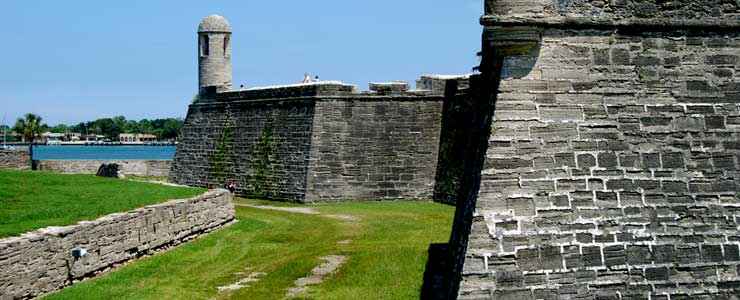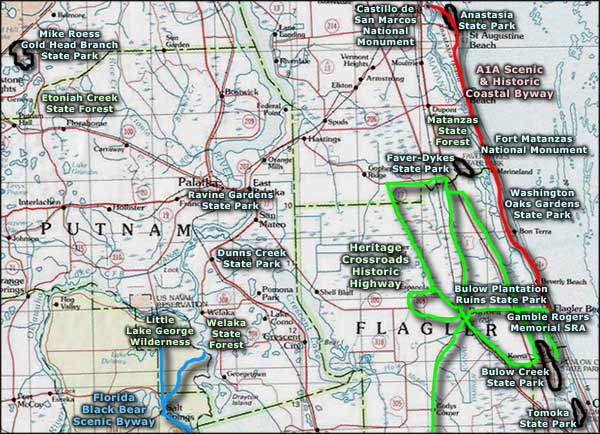Castillo de San Marcos National Monument

The north wall of Castillo de San Marcos

Castillo de San Marcos was built by Spanish forces with the aim of protecting the settlement at St. Augustine from depredation by foreign forces and English pirates. Construction of the masonry star fort took 23 years, beginning in 1672 and finally completed in 1695. The stone used was "coquina," ancient shells bonded together naturally to form a stone similar to limestone. The stone was quarried on Anastasia Island and ferried across the bay to construction site.
In November, 1702, British forces arrived from Charleston, South Carolina and took a run at breaching the fort's defenses. The coquina did an excellent job of absorbing the impacts of the British cannonballs and displayed almost no damage. Then the Spanish fleet arrived in the bay, trapping the British within. The British burned their ships (so they wouldn't fall into Spanish hands) and then marched overland back to Charleston.
Starting in 1738, Pedro Ruiz de Olano oversaw the redesign and rebuild of substantial sections of the fort. The interior was almost completely rebuilt with deeper rooms and vaulted ceilings. The new ceilings required that the outer walls of the fort be raised from 26 feet to 33 feet. That also allowed for cannon to be placed all along the gun deck and not just on the corner bastions.
The British came back again in 1739, and had pretty much the same results as before, except this time they didn't have to burn their ships and walk home. The British finally did get control of the fort but it was through "diplomacy." As a result of the Treaty of Paris in 1763, Britain gained control of all of Florida in return for giving Manila and Havana back to the Spanish.
Then came the American Revolution. St. Augustine was made the British capital of East Florida and British troops began making improvements to what was then Fort St. Mark. The fort saw its biggest use as a prison for several American patriots captured when the British took Charleston. The British were prevented from using the fort for much more than that by Spanish actions taken to the south. Spain declared war on Britain in 1779 and Bernardo de Gálvez, governor of Spanish Louisiana, got busy attacking several British settlements in south and west Florida and taking them. The Second Treaty of Paris (1783) returned Florida to Spanish control and Spanish troops re-entered the fort in 1784.
The Spaniards returned to a much different Florida to the one they had left. A lot of the Spanish settlers had left, a lot of British settlers had moved in and the United States was constantly putting pressure on the Spanish government in Florida. Finally, the Adams-Onis Treaty of 1819 gave Florida to the Americans. The Americans changed the name to Fort Marion.
Osceola, the famous Seminole warrior, was imprisoned at Fort Marion for a while in 1837. During the Civil War, the fort didn't play much of a role because Confederate troops stripped the place of cannons and then evacuated themselves from St. Augustine. Union troops came in March, 1862, and took the city and the fort without firing a shot. For the rest of the war, it was used as a Union prison. Beginning in 1875, many Native Americans were jailed there, waiting for transport to Indian Territory (Oklahoma). 1898 saw the fort used to imprison more than 200 deserters from the Spanish-American War. In 1900, the fort was decommissioned after 205 years of service under five different flags.
Castillo de San Marcos was declared a National Monument in 1924 and transferred into the care of the National Park Service in 1933. In 1942, it was given back its original Spanish name. 1966 saw the property listed on the National Register of Historic Places and in 1975 it was designated as a Historic Civil Engineering Landmark.

An aerial view of the Castillo de San Marcos National Monument
Photo of the gun deck courtesy of Wikipedia userid Oydman, CCA-by-SA 3.0 License
Photo of the North Wall of Castillo de San Marcos courtesy of Victor Patel, CCA-by-SA 3.0 License
